
Bent 38 Central Artery Pole
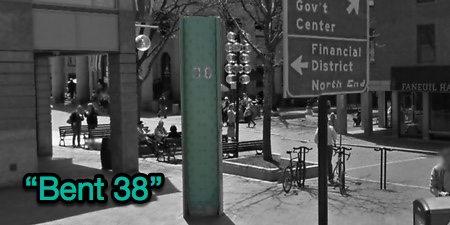
On the corner of Clinton Street and John F Fitzgerald Surface Rd, near Quincy Market lies a memorial to the elevated part of the John F. Fitzgerald Expressway.
The John F. Fitzgerald Expressway was a section of the highway in downtown Boston. Part of the highway was elevated from South Station to North Station, essentially splitting the North End section of Boston from the rest of the city.
Bostonians called this part of the highway many names: The Southeast Expressway, the Central Artery, Interstate 93, Route 3, the X-way, the Sexway, the Messway, Green Horror, and the Distressway.
Central Artery Trivia
- John Francis Fitzgerald (February 11, 1863 - October 2, 1950) was a mayor of Boston from 1906 to 1908 and again 1910 to 1914.
- His daughter Rose married Joseph P. Kennedy, Sr., the son of his political rival P. J. Kennedy.
- The name the Central Artery to John F. Fitzgerald Expressway was proposed by Robert F. Murphy of Malden on January 16, 1951
- In 1959, Rep. Gerald F. Doherty filed a bill to name the highway James M. Curley Highway.
- Constructions of the Fitzgerald Expressway began in 1952.
- On opening day (June 25, 1959) of the completed North-South highway, 114,184 vichicles used the new road.
- The inital Central Artery was estimated to cost $68,758,000 over 25 years.
- The completed highway cost $450,000,000 paid by state highway bond funds.
- By the 1990's the accident rate on the elevated highway part was four times the national average.
Memorial Inscription
PermalinkBent 38
The elevated John F. Fitzgerald Expressway was one of the Commonwealth's most ambitious and controversial urban redevelopment projects, Built by the Massachusetts Department of Public Works between 1951 and 1959 its downtown Boston route stretched from Dewey Square to North Station and allowed the growing crowds of suburban commuters to bypass the city's narrow streets. Twenty thousand citizens we displaced and hundred of buildings were demolished to build the six-lane skyway. Nevertheless, planners hoped that i.e. would alleviate congestion and simplify interurban travel.
Over the next 31 years the Expressway's daily capacity grew from approximately 75,000 vehicles in 1959 to nearly 200,000 vehicles in 1990. Pollution and traffic jams became a regular part of the city skyline, while the Waterfront and North End languished in the shadow grease and grime of the Boston's "other Green Monster." Between 1990 and 2007, the Central Artery/Tunnel Project redirected I-93 into a modern network of downtown tunnels. It also demolished the dilapidated Fitzgerald Expressway restored the city's surface roads and created the Rose Kennedy Greenway.
This structural column knowns as "Bent 38" still rests on its original foundations and is the only piece of the elevated highway that was left undisturbed by construction. It remains as a memorial to the Expressway and to the impact that the health of our transportation system have upon the life of our community. It also symbolizes the labor of scores of men and women who work to improve our city every day.
Eugène Létang Bronze Tablet
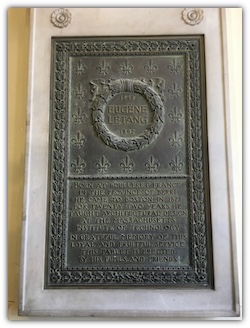
On the third floor in the McKim Building of the Boston Public library is a bronze tablet memorial for Eugène Létang. You can find this tablet just before you enter the Arts section.
The tablet reads: "1892 Born at the Boulleret France In the Province of Berri. He came to Boston in 1871 For Twenty Two Years He Taught Architectural Design At the Massachusetts Institute of Technology In Grateful Memory of this Loyal and Fruitful Service The tablet is erected By his Pupils and Friends"
The Letang memorial is a bronze tablet in a white marble frame. The upper part of the marble frame consists of a carved molding in Greek design.
The tablet was placed on December 31st, 1896, about four years after his death.
Here are some things I have learned about Eugène Létang and the tablet
- Graduate of the Ecole des Beaux-Arts in Paris
- Served in the Franco-Prussian War.
- In the spring of 1872, he was recruited to MIT and be part of the newly formed Architecture school by William Robert Ware to teach design.
- He was a very strict Professor. He was known to focused on architecture quality and simplicity.
- He would call his students "his boys"
- Was one of the judges for the first American Architect Small House design challenge in 1882.
- The memorial tablet was designed by William Everett Chamberlain, who studied under Professor Létang. Mr. Chamberlain later went on to be a successful designer. Among his work was the Mount Auburn Hospital. MIT has an annual award named after him. The award is given to an architecture senior for academic excellence.
- Professor Létang is credited for making the Institute of Technology school of Architecture be so well known and respected.
- He was involved with the architecture design of the Boston Public Library and Century Club in New York.
- Eugene Letang died on November 29, 1892. He was buried at Forest Hills Cemetery in the family tomb.
Apple Store (Boston)
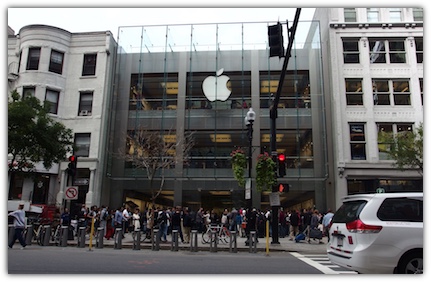
On May 15, 2008, Apple open its first store in Downtown Boston at 815 Boylston St. Apple knew that the business opportunity in Boston would be huge (Educational market) and they wanted to have a store to meet that demand.
In 2000, Apple sought out the 815 Boylston Street location, but had to wait until the lease ran out for all the tenants. They had the opportunity to build a two-floor store in 2005 but wanted to wait a year until the last tenant left so they could have the whole building and have more flexibility.
In 2007, Apple demolished the building and put in a modern three story building with a green roof and the front made largely of glass.
Previous Tenant
Copy Cop was a printing shop located at the street level at 815 Boylston St. The building was built in 1906 and had been under numerous renovations. According to Apple development team, there was no significant architectural value to keep the previous structure.
The two buildings around 815 Boylston St. had both seen demolitions in recent years. Fidelity Investments occupy one of the building and Sir Speedy occupies the other recently demolished buildings. (Oddly enough Sir Speedy was a competitor to Copy Cop before they moved out of the Apple location.)
What makes the Boston store special
The Boston Apple store is 21,350-square-foot which makes it the largest Apple store in the United States. The average Apple Store is 8,400-square-feet.
Other notable larger Apple Stores:
- Apple Palo Alto store is 15,030-square-feet.
- Shanghai Pudong Store is 16,000-square-feet.
- New York’s Grand Central Terminal store in New York City is 20,000-square-feet.
- London’s Covent Garden store is 30,000-square-feet.
Other Notable Retailers average store sizes:
- CompUSA was 107,000-square-feet.
- Best Buy stores are roughly 28,032-square-feet
- Microsoft is 7,500-square-feet.
The Boston Store has a central spiral glass staircase. The Faraone Imperiale glass spiral staircase cost about $25,000.
The floor throughout the store has grey-blue Pietra Serena sandstone imported from Firenzuola, Italy. These are the flooring that Steve Jobs personally wanted to have in the stores because they were authentic Italian and had high integrity. When you walk around the store, your walking on the same type of flooring that is used around Florence, Italy.
When the store the open in 2008, the layout was: the first floor was dedicated to Macs (iMac, MacBook, MacBook Pro, MacBook Air, Mac mini, Mac Pro); the second floor was devoted to smaller devices (anything running iOS), including iPhones and iPods (iPod touch, iPod nano, iPod shuffle, iPod classic); and the third floor featured the famed Genius Bar, where customers could get technical help. Concierge staff will be available on each floor just to help consumers navigate the building. (Note: The iPad had not come out when the store opened!)
Today, the first floor usually showcase some of the recently announced products such as the Apple Watch and iPads. There are 165 store workers -the Geniuses, Specialists, and Creatives at the Boston Apple Store.
Product Launches
Whenever Apple does a major product release, you will see a long line at the Boston Apple Store. Usually, the line starts about 24 hours before the official sale date. Local media will have their trucks park on Boylston street to talk about the product launch on the nightly news. (If the line is long and if it's a slow news day.)
Note: When you see a line at the Apple Store it's usually just customers waiting to purchase the newest products. You can still go inside the store and try out the new products.
Brief History of the Relationship of Apple and Boston
Macintosh Computer Introduction
On January 30, 1984, Steve Jobs demonstrated the Macintosh to the Boston Computer Society at MIT. The demonstration was a week after the official announcement at the Apple Investment meeting. This was the first public viewing of the Macintosh. Steve Jobs wanted to showcase the computer to diehard computer fans.
MacWorld Boston
During the summer of the 1980s and through the mid-1990s there was an annual gathering of Apple enthusiasts at MacWorld Boston. Apple would use these conferences to announce new products. The most famous moment was in 1997 when Steve Jobs returned to Apple and announced that Microsoft, a big competitor at the time, decided to invest $150 million in Apple stock.
Apple and Boston had a bit of a fallout in 1997 when Apple decided to move the conference to New York for a bigger venue and be closer to New York city graphic designers - a key demographic at the time.
MacWorld came back to Boston in 2004 and 2005 but without Apple participation - resulting into a much smaller conference.
Getting to the Store
The nearest T stop is the Green line’s stop at Copley Square, it's a nice four-minute walk to the Apple Store. When you exit the Copley T station, look for the Prudential Building and walk towards it. The Apple Store is across from the Prudential Mall. The big glass front face is hard to miss.
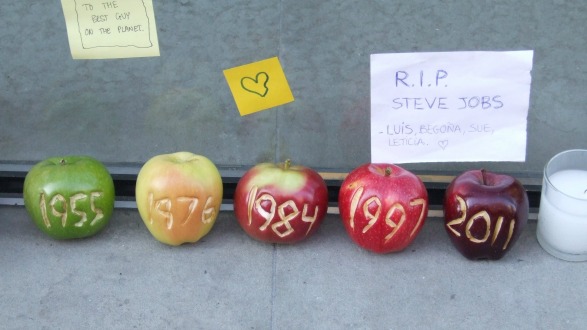
Boston Stone
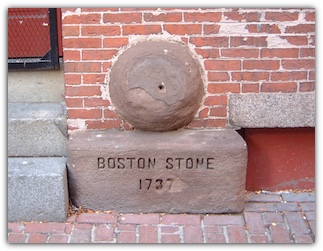
The Boston Stone is set into the wall of a building on 9 Marshall Street. It is really two stones - a rectangular base, with the carved inscription "Boston Stone, 1737," surmounted by a stone ball.
The Boston Stone has been a local landmark since it "magically" appeared in the 1700s. In 1835, it became an official Boston Landmark.
Here's some information Boston Stone trivia that I found:
There was no record of the "Boston Stone" until around 1770.
On the 'Boston Stone' is the year 1737. In my research, no one was able to identify the meaning of the date.
I came up with two possibilities:
- Celebrate the Irish Heritage - The first formal St. Patrick's Day celebration in Boston was in 1737.
- Commemorate John Hancock - John Hancock was born January 23, 1737.
Some people think that the stone was use as the central point of mileage measurement from the city of Boston. It's only a legend, as the new State House has always is the central point of mileage to Boston.
The stone actually had a purpose it was originally a paint mill, imported from England around 1700 by Painter Thomas Child (1655-1706), who owned the property. The long stone in which a painter would ground and mixed his paint by rolling a circular stone ball back and forth.
When Thomas Child died, John Howe purchased the property and place the long stone and stone ball to the corner of the property to protect it from passing carts.
The wooden house that Thomas Child and John Howe lived in was taken down in 1835. The stone was relocated and put into the new brick building that is standing today.
The top circular stone use to have an eagle on it. (Probably placed sometime 1875 - America Centennial Celebration)
The Boston Stone was was originally stops of the Boston Freedom Trail in the 1950s.
Real Meaning of the Boston Stone
Around the turn of the century, when people would ask about the stone they were given a pamphlet with the following description:
The old wooden house now standing, has for many generations been occupied by a Painter. When the grandfather of the present owner. Mr. John Rowe purchased the house, a large stone was found in the yard. It was hollowed out on one side, used to grind paint. Being of no use in the yard, it was removed to the corner of the house to prevent carts from injuring the building. When I was a boy, in passing the building, I saw a lad named Joe Whiting, whose father occupied the shop, writing on the stone these words - "Boston Stone, Marshall Lane." After I became a man I asked Mr. Whiting who set the boy to work on the stone. He said, "Marshal Lane" at that time no being named, it was difficult to designate his place of business. A Scotchman who opened a shop for the sale of Ale and Cheese directly opposite made a complaint of the difficulty. He said, in London there was a large stone at a certain corner, marked "London Stone," which served as a direction to all places near it, and if I would let Joe write the words "Boston Stone" on this, people would notice it, and it would set them guessing what it meant, and it would become a good landmark.
Now you know. The Boston Stone is nothing more than an 18th Century marketing tool to get people to go down Marshall Street.
PermalinkSacred Cod of Massachusetts
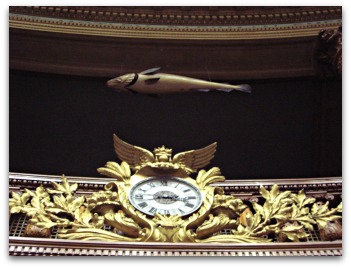
The Sacred Cod is a four-foot, eleven-inch carved-wood effigy of an Atlantic codfish, hanging in the public viewing gallery of the House of Representatives chamber in the Boston's Massachusetts State House. It was placed in the House of Representative chamber ceiling in 1784 to commemorate the importance of the fishing industry to the Bay State.
Sacred Cod History
There have been three versions of the Sacred Cod:
- 1700s - 1747 - Displayed in the Old State House, destroyed by fire.
- 1747 - 1774 - Stolen by the British during the Revolutionary war.
- 1784 - Today - Moved to the new State House in 1895.
Stealing the Sacred Cod
There have been two cases of people stealing the Sacred Cod:
- April 16, 1933, some Harvard Lampoon students stole it, it was returned a few days later in a dramatic fashion. A phone call to the Harvard University Police to have them follow a car with no license plate. After a brief slow speed chase, the car pulled over and two men handed over the Cod and sped away. The Cod was returned about 50 hours after it was stolen.
- November 16, 1968, some Boston UMass students stole the Sacred Cod and was returned a few days later.
President Frankin D, Roosevelt
In 1941, the Sacred Cod became a topic when President Franklin D, Roosevelt visited Boston during a time when there was a push to use aluminum as part of the World War 2 defense. President Roosevelt was invited to visit Boston to start the nation-wide aluminum drive.
According to the Boston Globe, Franklin R. Roosevelt said, "I have been informed that the Sacred Cod emblem of Massachusetts, which hangs in your august chamber, is made of aluminum, or of aluminum sections. I think it would be a generous gesture and an example to the rest of the citizenry if the members of your honorable body voted to contribute the code to the cause of the defense."
The Sacred Cod is under the Massachusetts State Art Commission control, and they did not approve of removing it from the chamber. (There's no indication that they actually took President Frankin D, Roosevelt offer seriously.)
Assorted Sacred Cod Trivia
- John Hancock was the sitting Massachusetts Governor when the original Sacred Cod was given to the House of Representatives.
- The Sacred Cod is made of mostly pine and there's barely any trace of aluminum. The Sacred Cod is Four feet, 11 1/2 inches long, 10 inches wide at its fin point.
- In 1965, the Sacred Cod was cleaned, and when it was placed back it was hung backward facing the South. For 70 years, it was facing North.
- In 1937, some representatives wanted the Cod to be replaced by a greyhound as a tribute to "the power of the dog track operators." In 2008, Massachusetts eliminated Greyhound racing via Question 3 on the November 4, 2008, ballot. The last greyhound race was on December 26, 2009, at Raynham Park.
Viewing the Sacred Cod
You can see the Sacred Cod on a tour of the Massachusetts State House. Tour of the State House is free. You are allowed to take pictures inside the State House.
PermalinkNickys Peanut Cart at Fenway Park
One of the oldest family businesses in Boston is the family that runs the Peanut cart near Gate 'A' at Fenway Park. The Jacobs family has been serving bag fresh roasted peanuts at Fenway Park since April 20, 1912. That's 104 years of service. As far as I know, the Paget family, who own the Swan Boats at the Boston Public Gardens have a long family tradition. (The Paget family started back in 1877.)
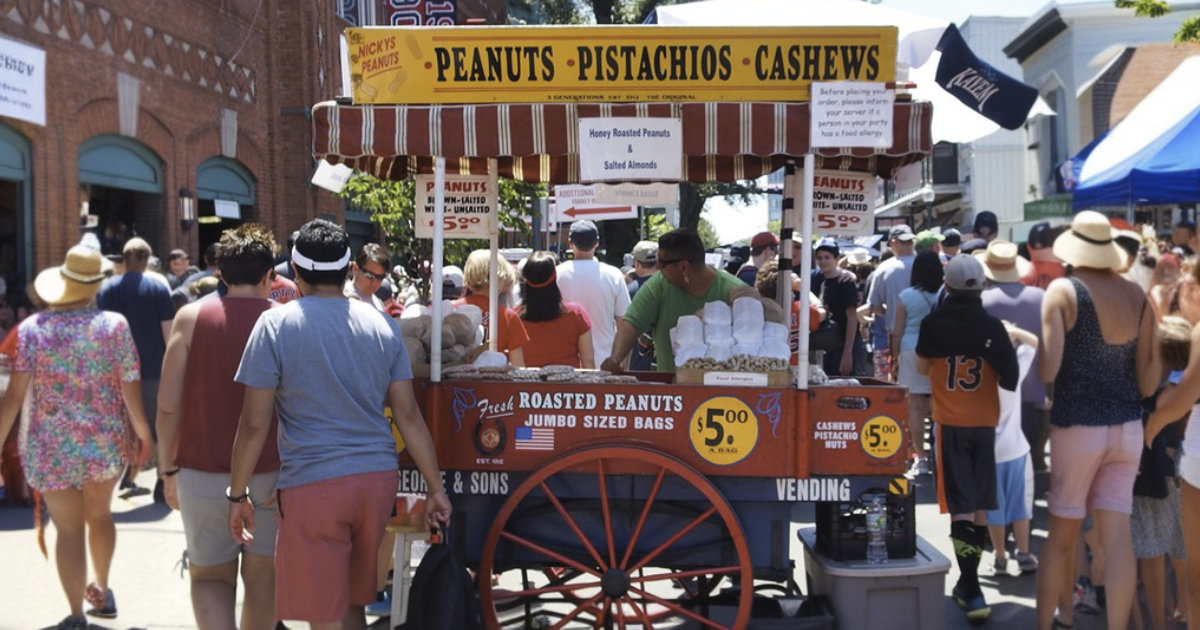
Family Cart History
- 1912 - 1945 -- Peter Davis
- 1945 - 1988 -- George Jacobs - "The Peanut Man," sold Peanuts from the stand from 1945 until he died in 1988.
- 1988 - Current -- Nicky Jacobs - Grandson of Peter Davis
Currently the cost of a Peanut bag at Nicky's Cart cost $5. Nicky Cart is not the original cart from 1912, he built the current art in 2000 using some of the parts of the original carts. Nicky still has the original cart.
Unfortunately Nicky's Peanut cart business about to end. In 1999, the management team at Fenway Park has requested that all outside food vendors be removed from Fenway park. Nicky's Peanut stand can still run, but when he dies or retires, the license can not be transferred to another person.
Currently there are 18 vendors that fall into the legacy category with Nicky's Peanuts being the oldest continuous outside vendor at Fenway Park. Vendors pay anywhere from $360 to $900 a year for the privilege to sell their goods.
Visiting Fenway Park
The next time your at a game at Fenway Park, why not enter at Gate 'A' and just before you enter, support one of the oldest Fenway Park tradition. You'll find the cart directly across the Red Sox ticketing area on Yawkey Way.
Fenway Game Day
- You are allowed to bring food into Fenway.
- You cannot bring in alcoholic beverages, soda, cans, and other various prohibited items.
- You're allowed one (sealed) bottle of water.
Thompson Island Cemetery
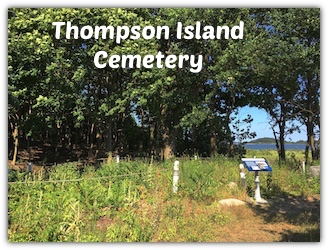
Thompson Island is the only Boston Harbor island to have a private graveyard. The graveyard is located on the southern tip of the island.
The sign at the site reads:
In 1842, 23 students who were being rewarded for good behavior with a fishing trip perished tragically in a boating accident. To honor these students the school created this cemetery. Nearly five decades later another boating mishap took the lives of seven more students they too are buried here. The cemetery also includes students or island residents who passed away from illness or accidents, as well as several pre-contact Indians whose remains were discovered on the island.
People that are burried here:
| Born | Died | |
| Charles W Ackers | 1870 | August 10, 1879 |
| James Roach | Nov. 20, 1873 | September 6, 1885 |
| Charles Lind | October 1, 1902 | |
| Unknown Wampanoag Indiana | (Skeleton remains were reburied in 1941) |
23 of the 29 Individuals that died in April 29, 1842, boating accident
Specific names were not found.
Seven of the 9 Individuals that died in April 10, 1892, boating accident
- George F. Ellis (16)
- Thomas Phillips (16)
- William W. Curran (17)
- Charles R. Graves (17)
- Harvey E. Loud (16)
- Adelbert H. Packard (16)

A view of Thompson Island Cemetery with overgrown weeds.
Some interesting information about the graveyard
- The cemetery has not been taken care of and many gravestones have sadly disappeared. There are lots of overgrown weeds growing throughout the cemetery.
- The only gravestone that is visible is Charles Lind who died on October 1, 1902.
- Based on various news sources there are 33 people buried at the graveyard.
- The graveyard seems very small for that many people being buried here. I estimate that the cemetery is 9 x 20.
- When the cemetery first opens the students at the Boston Farm would hold a special service on Memorial Day.
Thompson Island
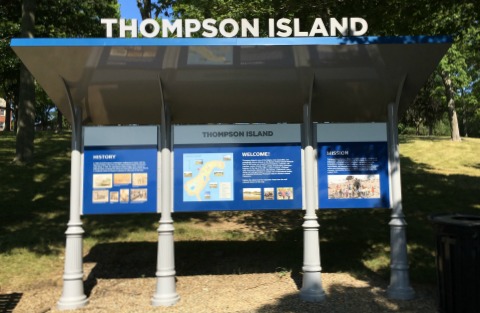
Thompson Island is one of the largest, most accessible and ecologically diverse islands in the Boston Harbor Islands National Recreation Area. The island is open to visitors on Saturdays and Sundays from Memorial Day through Labor Day; otherwise access is by arrangement only.
The only way to get to the island is to use the Charter Boats. Private boats are not allowed to dock on the island.
The Island is 157-acres on Boston Harbor.
History of the island
This is a good brief summary of the history of the island found on one of the trail signs on the island:
In 1626, David Thompson established a trading post to barter with the Neponset Indians. Over the next 200 years, farmers leased the island to graze sheep. In 1833, the educational mission began when a group of philanthropists purchased the island and open the Boston Farm school, a vocational school for Boston orphaned or otherwise at-risk boys.
Tragic History of the Island
There were two fatal boating accidents which resulted in the death of several students and faculty at the Boston Asylum and Farm School for Indigent Boys:
April 29, 1842 Boating incident. The student’s boat, called the Polka, capsized after a fishing trip to the outer harbor. 29 individuals died. (I wasn’t able to find any specific names.)
Sunday, April 10, 1892 - A similar type of boating accident, when a small gust of wind capsize the boat. According to stories at the time, everyone on the boat survived the capsized. They all held on to the boat waiting for a rescue. The wait was long and they kept talking to each other for encouragement. The rescue boat took too long and nine members died:
A. F. Norbert (40) Instructor, Frank F. Hitchcock (19), George F. Ellis (16), Thomas Phillips, (16), William W. Curran (17), Charles R. Graves (17), Harvey E. Loud, (16), Adelbert H. Packard (16)
In 1941, Skeleton remains were found, possibly belonging to Wampanoag Indiana which lived on the island.
Most of the victims of the two boat accidents, the Indian skeleton remains are buried at the graveyard on the south side of the Island.
Things I Learned on a recent trip
- David Thompson was only on the island for a couple of years - yet for 200 years the island has named after him!
- It takes about 30 minutes to get from EDIC to the island dock.
- In 1863, the Philanthropists paid $6,000 for the rights to the island. What cost $6,000 in 1833 would cost $148,541.13 in 2015.
- The boat travels about 10 knots, a bit slower than other motor boats in the harbor.
- The boat entry and exit is downstairs, upstairs has a great view of the Boston skyline. There was very little light on upstairs at night.
- If you go for a company event, there are two areas that you can use: Ocean Bluff Pavilion and Waterfront Landing . The Ocean Bluff Pavilion is better for bigger groups.
- Make sure to bring plenty of suntan lotion, bug spray and bottle water. There are plenty of places on the island to have a picnic.
- I had no problems accessing the Internet on the island.
- There are several large fields for kids to run around and to play various sports.
- The trails around the island gives you beautiful views of Boston Harbor.
- There are various history spots where you learn what the boys at the Boston Farm School used at that location.
- On the Northern side of the island, you can see Airplanes taking off at nearby Logan Airport and then taking a sharp left over the island.
How do you get on the Island?
You get to the island from a private boat shuttle at the EDIC Pier in South Boston. Boat service is only available on weekends from Memorial Day weekend through Labor Day weekend, or via private events.
Ferry service is cash fare. Adult: $17.00 per person, round trip. Children 3-12: $10 per child, round trip / under 3 years ride free. There are no island fee charges.
Corporate Events

Thompson Island is an excellent place for a summer outing. They offer excellent catering services and there is plenty of room on the island for any social gathering.
Be sure to check out Challenge Field as it’s a really cool team building exercise. If you don't do it, at least walk by the Challenge field to see what your missing!
Each Thompson Island venue comes equipped with the following:
- Volleyball, Horseshoes, Corn Hole, Ladder Ball, Can Jam,
- Bocce balls, frisbees, footballs, soccer balls, dodge balls,
- wiffle ball and softball (must provide own glove)
- Adirondack chairs and hammocks, trail maps for self-guided nature walks
Boston Replica Libery Bell Location
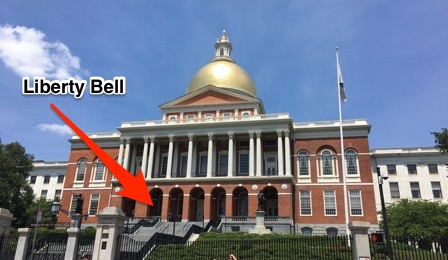
On July 6, 1950, Boston got a replica of the famous Liberty Bell. The was inside the entrance, Dorris Hall for about 7 years before it was moved outside the front doors of the Massachusetts State House.
The front of the State Building is a secure area and only the "President" can go out there. At least that what I was told by one of the Serjeant-at-arms that stood by the front door. You can't get a good look at the Bell without a good camera zoom.
Things that I have learned about the bell.
Prior to September 11, 2001, tourist visiting Boston were able to walk up the front steps and touch the bell. This would be the first thing they would encounter before they enter the building.
Today, the Liberty Bell is barely visible from Beacon Street. When you're looking at the state house the bell is just to the left of the front doors, underneath the second window to the left of the door.
While you can only see the Liberty Bell from the steps of the State House, if you go inside to the second floor, you can get a slightly better view of the bell. You do have to ask permission to get behind a desk to see the bell.
A plaque near the bell reads "In standing before this symbol you have the opportunity to dedicate yourself as did our founding fathers, to the principles of the individual freedom for which our nation stands."
The replica Liberty Bell was cast by the Paccard Bell Foundry, which is based in France, in 1950. They produced 300 replicas, and there's one in every state of the USA.
The Liberty Bell in Puerto Rico is in the Polvorin de San Geronimo in the Parque Luis Munoz Rivera in the Porta de Tierra area.)
In Washington DC, The Liberty Bell is on display outside at Union Station. Where anyone can walk up and ring the bell.
You can buy a replica copy of the bell from Paccard Bell Foundry for your home for $3,000. They have a Bronze Bell N*2 - Wooden Handle version for around $25.
The golden dome of the State House serves as the official location of Boston to mapmakers. A sign that says "50 miles to Boston" really means fifty miles to the golden dome.
PermalinkBoda Borg
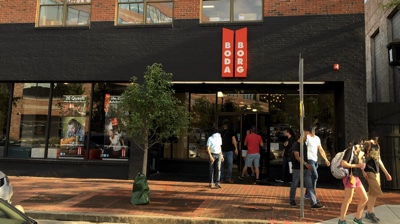
Are you thinking about a unique team building activity in the Boston area? Checkout Boda Borg in Malden for a fun 3 hour adventure.
Just what is this Boda Borg thing?
You are on a quest to solve some very creative mini-challenges.
There are various rooms will all sorts of tasks for you to complete in order to move to the next room with another similar challenge.
Some of these tasks might involve you to think logically, while others are physical challenges.
When you successfully complete a challenge, you unlock a box and then you can stamp your passport to show everyone that your team succeeded.
This is certainly a good way to get the team to think together and figure out how to solve the non-business type of problems. You really do need to think outside the box.
After the Quest
If you're looking for a good decompression place to go and talk after the event, visit the Malden Station. It's a great burger bar that has a lot of microbrews on tap. It's only a block away from Boda Borg.
How to get there.
Boda Borg is located in Malden Center, just a few blocks away from the Malden T station. It's about a 30-minute ride on the Orange line from Back Bay to the station.
There is parking across the street for $2 with validation from Boda Borg.
Things I learn about the Boda Borg Quest in Malden
- This is the first Boda Borg in North America. The First Quest was on Saturday October 3, 2015.
- The building once house Sparks Department Store
- Boda Borg spent $4 million to renovate the facility
- The Malden location is 30,000 square feet
- There are quest rooms on the first floor and the basement. Some people said the first floor quest were easier than the basement.
- Dress in loose clothing, many people wore shorts and running shirts. Sneakers please - no sandals. (You'll understand after a couple of quests.)
- Each quest rooms are small in size, about 12 x 12.
- If you get stuck with any challenge, you can ask a Boda Borg for a hint.
- They have plenty of drinks and ice cream in the lobby.
- 5-Wits in Foxboro is similar teaming experience
- 300 People can quest at the same time.
- If there are a lot of people then you may end up waiting up to 10 mins between tries. But that might be just enough time to think about why you failed a particular task.
- If you are going here with friends, make sure to have enough people so that there are 3-4 people in each team.
- After a few hours of quest, I feel the perfect number of team players is three.
- They do have lockers in the basement, don't forget to bring your own padlocks!
- Before going, make sure to fill out the standard waiver form.
If you're searching the Internet for hints for some of the quests adventures, you're missing the point:
Details of each challenge must be shrouded in secrecy, - if a guest knows too much, what's the point of questing.
"We don't sell success, we sell failures." David Spigner CEO Boda Borg
Team Reservations Information
Boda Borg is located on 90 Pleasant St, Malden, MA 02148, you can call them at (781) 321-1081.
PermalinkAbout
There are many interesting things and places around Boston, MA that you should know about. Here are a few that caught my attention. From historical sites such as the USS Constitution Museum, the Freedom Trail, and the iconic Fenway Park, to modern attractions like the New England Aquarium, the Boston Public Market, and the Isabella Stewart Gardner Museum, there is something for everyone. Whether you are looking for a fun family trip or a romantic getaway, Boston has it all.
Check out all the blog posts.
Blog Schedule
| Sunday 13 | Misc |
| Monday 14 | Media |
| Tuesday 15 | QA |
| Wednesday 16 | Pytest |
| Thursday 17 | PlayWright |
| Friday 18 | Macintosh |
| Saturday 19 | Internet Tools |
Other Posts
- Thanksgiving Proclamation of 1817
- Coconut Grove Night Club Fire
- Palazzo Ducale Model in the North End
- Martin Park
- Phillips Brooks Statue
- Rachel Revere Park
- Vendome Hotel Fire Monument
- Boda Borg
- Boston Logan International Airport
- Boston Gas Lamps
- Certificate of Occupancy
- Durgin Park
- Washington Portrait at the Boston Public Library
- Sándor Petőfi Memorial at the Prudential Mall
- Louisa May Alcott House